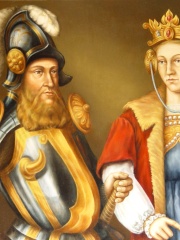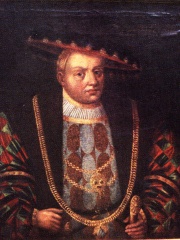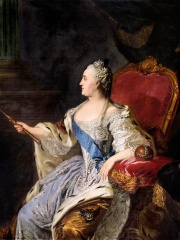
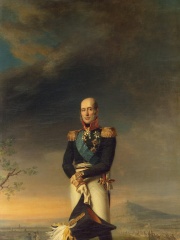
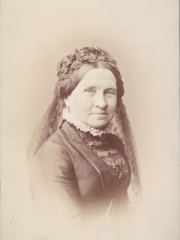
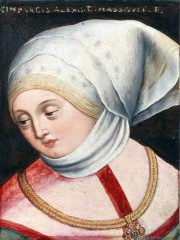
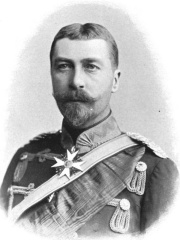
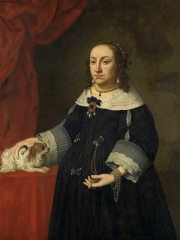
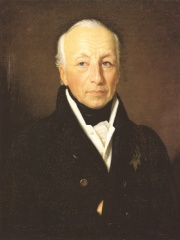

The Most Famous
NOBLEMEN from Poland
Top 10
The following people are considered by Pantheon to be the top 10 most legendary Polish Noblemen of all time. This list of famous Polish Noblemen is sorted by HPI (Historical Popularity Index), a metric that aggregates information on a biography's online popularity. Visit the rankings page to view the entire list of Polish Noblemen.

1. Catherine the Great (1729 - 1796)
With an HPI of 86.60, Catherine the Great is the most famous Polish Nobleman. Her biography has been translated into 119 different languages on wikipedia.
Catherine II (born Princess Sophia Augusta Frederica of Anhalt-Zerbst; 2 May 1729 – 17 November 1796), commonly known as Catherine the Great, was the reigning Empress of Russia from 1762 to 1796. She came to power after a coup d'etat against her husband, Peter III. Her long reign helped Russia thrive under a golden age during the Enlightenment. This renaissance led to the founding of many new cities, universities, and theatres, along with large-scale immigration from the rest of Europe and the recognition of Russia as one of the great powers of Europe. After overthrowing and possibly assassinating her husband and her subsequent rule of the Russian Empire, Catherine often relied on noble favourites such as Count Grigory Orlov and Grigory Potemkin. Assisted by highly successful generals such as Alexander Suvorov and Pyotr Rumyantsev and admirals such as Samuel Greig and Fyodor Ushakov, she governed at a time when the Russian Empire was expanding rapidly by conquest and diplomacy. In the west, she installed her former lover to the throne of Poland, which was eventually partitioned. In the south, the Crimean Khanate was annexed following victories over the Bar Confederation and the Ottoman Empire in the Russo-Turkish War. With the support of Great Britain, Russia colonised the territories of New Russia along the coasts of the Black and Azov Seas. In the east, Russians became the first Europeans to colonise Alaska, establishing Russian America. Many cities and towns were founded on Catherine's orders in the newly conquered lands, most notably Yekaterinoslav, Kherson, Nikolayev, and Sevastopol. An admirer of Peter the Great, Catherine continued to modernise Russia along Western European culture. However, military conscription and the economy continued to depend on serfdom, and the increasing demands of the state and of private landowners intensified the exploitation of serf labour. This was one of the chief reasons behind rebellions, including Pugachev's Rebellion of Cossacks, nomads, peoples of the Volga, and peasants. The Manifesto on Freedom of the Nobility, issued during the short reign of Peter III and confirmed by Catherine, freed Russian nobles from compulsory military or state service. The construction of many mansions of the nobility in the classical style endorsed by the empress changed the face of the country. She is often included in the ranks of the enlightened despots. Catherine presided over the age of the Russian Enlightenment and established the Smolny Institute of Noble Maidens, the first state-financed higher education institution for women in Europe.

2. Michael Andreas Barclay de Tolly (1761 - 1818)
With an HPI of 72.79, Michael Andreas Barclay de Tolly is the 2nd most famous Polish Nobleman. His biography has been translated into 49 different languages.
Prince Michael Andreas Barclay de Tolly (baptised 27 December [O.S. 16 December] 1761 – 26 May [O.S. 14 May] 1818) was a Russian field marshal who figured prominently in the Napoleonic Wars. Barclay was born into a Baltic German family from Livland. His father was the first of his family to be accepted into the Russian nobility. In Russian service he was known as Mikhail Bogdanovich. Barclay joined the Imperial Russian Army at a young age in 1776. He served with distinction in the Russo-Turkish War (1787–92), the Russo-Swedish War (1788–1790), and the Kościuszko Uprising (1794). In 1806, Barclay began commanding in the Napoleonic Wars, distinguishing himself at the Battle of Pułtusk that same year. He was wounded at the Battle of Eylau in 1807 while his troops were covering the retreat of the Russian army. Because of his wounds, he was forced to leave command. The following year, he carried out successful operations in the Finnish War against Sweden. Barclay led a large number of Russian troops approximately 100 km (62 mi) across the frozen Gulf of Bothnia in winter during a snowstorm. For his accomplishments, Barclay de Tolly was made a General of the Infantry and appointed Governor-General of the Grand Duchy of Finland. From 20 January 1810 to September 1812 he was the Minister of War of the Russian Empire. When the French invasion of Russia began in 1812, Barclay de Tolly was commander of the 1st Army of the West, the largest Army to face Napoleon. Barclay initiated a scorched earth policy from the beginning of the campaign, though this made him unpopular among Russians. After the Battle of Smolensk failed to halt the French and discontent among Russians continued to grow, Alexander I appointed Mikhail Kutuzov as Commander-in-Chief, though Barclay remained in charge of the 1st Army. However, Kutuzov continued the same scorched earth retreat up to Moscow where the Battle of Borodino took place nearby. Barclay commanded the right wing and center of the Russian army for the battle. After Napoleon's retreat, the eventual success of Barclay's tactics made him a hero among Russians. He became Commander-in-Chief in 1813 after the battle of Bautzen, replacing Wittgenstein (who had been appointed after Kutuzov's death early in 1813) and led the taking of Paris, for which he was made a Field Marshal. His health later declined and he died on a visit to Germany in 1818.

3. Julia, Princess of Battenberg (1825 - 1895)
With an HPI of 71.34, Julia, Princess of Battenberg is the 3rd most famous Polish Nobleman. Her biography has been translated into 29 different languages.
Julia, Princess of Battenberg, previously Countess Julia von Hauke and Countess of Battenberg (born Julia Therese Salomea Hauke; 24 November [O.S. 12 November] 1825 – 19 September 1895), was the wife of Prince Alexander of Hesse and by Rhine, the third son of Louis II, Grand Duke of Hesse. The daughter of a Polish general of German descent, Julia was not of royal origin. She became a lady-in-waiting to Marie of Hesse, wife of the future Russian Emperor Alexander II and a sister of Alexander, whom Julia married after meeting him in the course of her duties. Although the marriage of social unequals like Julia and Alexander was deemed morganatic, the Duke of Hesse made her Princess of Battenberg. Julia was the mother of Alexander, Prince of Bulgaria, and she is an ancestor of the current British and Spanish royal families.

4. Cymburgis of Masovia (1394 - 1429)
With an HPI of 69.01, Cymburgis of Masovia is the 4th most famous Polish Nobleman. Her biography has been translated into 26 different languages.
Cymburgis of Masovia (Polish: Cymbarka mazowiecka; German: Cimburgis von Masowien; 1394 or 1397 – 28 September 1429), also spelled Zimburgis or Cimburga, was a Princess of Masovia of the Polish Piast dynasty and a Duchess of Austria from 1412 until 1424, by her marriage with the Habsburg duke Ernest the Iron. As the mother of later Emperor Frederick III, Cymburgis, after Gertrude of Hohenberg, became the second female ancestor of all later Habsburgs, as only her husband's Ernestine branch of the family survived in the male line.
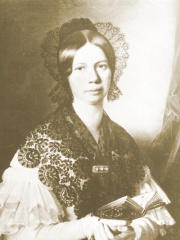
5. Duchess Maria Dorothea of Württemberg (1797 - 1855)
With an HPI of 64.91, Duchess Maria Dorothea of Württemberg is the 5th most famous Polish Nobleman. Her biography has been translated into 24 different languages.
Duchess Maria Dorothea of Württemberg (Maria Dorothea Luise Wilhelmine Caroline; 1 November 1797 in Carlsruhe (now Pokój), Silesia – 30 March 1855 in Pest, Hungary) was the daughter of Duke Louis of Württemberg (1756–1817) and Princess Henriette of Nassau-Weilburg (1780–1857).

6. Ernst Gunther, Duke of Schleswig-Holstein (1863 - 1921)
With an HPI of 64.40, Ernst Gunther, Duke of Schleswig-Holstein is the 6th most famous Polish Nobleman. His biography has been translated into 19 different languages.
Ernst Gunther II, Duke of Schleswig-Holstein (11 August 1863 – 22 February 1921), was a son of Frederick VIII, Duke of Schleswig-Holstein and Princess Adelheid of Hohenlohe-Langenburg. He inherited his father's title as titular third duke of Schleswig-Holstein.

7. Anna Catherine Constance Vasa (1619 - 1651)
With an HPI of 64.34, Anna Catherine Constance Vasa is the 7th most famous Polish Nobleman. Her biography has been translated into 21 different languages.
Anna Catherine Constance Vasa (Polish: Anna Katarzyna Konstancja Waza; 7 August 1619 – 8 October 1651) was a Polish princess, daughter of King Sigismund III Vasa and his second wife, Constance of Austria.

8. Peter I, Grand Duke of Oldenburg (1755 - 1829)
With an HPI of 64.15, Peter I, Grand Duke of Oldenburg is the 8th most famous Polish Nobleman. His biography has been translated into 22 different languages.
Peter I or Peter Frederick Louis of Holstein-Gottorp (German: Peter Friedrich Ludwig von Holstein-Gottorp) (17 January 1755 – 21 May 1829) was the Regent of the Duchy of Oldenburg for his incapacitated cousin William I from 1785 to 1823, and then served himself as Duke from 1823 to 1829. He also served from 1785 to 1803 as the last Lutheran Prince-Bishop of Lübeck, until that Prince-Bishopric was secularized and joined to Oldenburg. His son, Augustus, was the first Duke of Oldenburg to use the style of Grand Duke that was granted in 1815.

9. Richeza of Poland, Queen of Castile (1140 - 1185)
With an HPI of 63.75, Richeza of Poland, Queen of Castile is the 9th most famous Polish Nobleman. Her biography has been translated into 21 different languages.
Richeza of Poland (also known as Richeza of Silesia; Polish: Ryksa śląska; c. 1140 – 16 June 1185) was a Polish noblewoman of the House of Piast in the Silesian branch. By her marriages she was Queen consort of Galicia, León and Castile, Countess of Provence, and Countess of Eberstein. Richeza was the third child and only daughter of Władysław II the Exile, the High Duke of Poland and ruler of Silesia, by his wife Agnes of Babenberg, daughter of Margrave Leopold III of Austria and half-sister of King Conrad III of Germany.
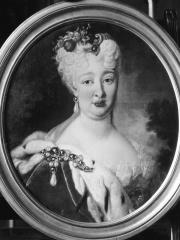
10. Countess Palatine Elisabeth Auguste Sofie of Neuburg (1693 - 1728)
With an HPI of 63.18, Countess Palatine Elisabeth Auguste Sofie of Neuburg is the 10th most famous Polish Nobleman. Her biography has been translated into 17 different languages.
Elisabeth Auguste of Neuburg (Elisabeth Auguste Sofie; 1693–1728) was the only surviving child of Charles III Philip, Elector Palatine. The Palatinate-Neuburg line became extinct with her father and was succeeded by the Palatinate-Sulzbach line. Her sons with Count Palatine Joseph Charles of Sulzbach would have been the indisputable heirs to the Electorate of the Palatinate, but they all died in infancy. By her marriage, she became Hereditary Princess of Sulzbach.
People
Pantheon has 20 people classified as Polish noblemen born between 1140 and 1879. Of these 20, none of them are still alive today. The most famous deceased Polish noblemen include Catherine the Great, Michael Andreas Barclay de Tolly, and Julia, Princess of Battenberg.
Deceased Polish Noblemen
Go to all RankingsCatherine the Great
1729 - 1796
HPI: 86.60
Michael Andreas Barclay de Tolly
1761 - 1818
HPI: 72.79
Julia, Princess of Battenberg
1825 - 1895
HPI: 71.34
Cymburgis of Masovia
1394 - 1429
HPI: 69.01
Duchess Maria Dorothea of Württemberg
1797 - 1855
HPI: 64.91
Ernst Gunther, Duke of Schleswig-Holstein
1863 - 1921
HPI: 64.40
Anna Catherine Constance Vasa
1619 - 1651
HPI: 64.34
Peter I, Grand Duke of Oldenburg
1755 - 1829
HPI: 64.15
Richeza of Poland, Queen of Castile
1140 - 1185
HPI: 63.75
Countess Palatine Elisabeth Auguste Sofie of Neuburg
1693 - 1728
HPI: 63.18
Bogislaw V, Duke of Pomerania
1318 - 1374
HPI: 61.25
Bogislaw X, Duke of Pomerania
1454 - 1523
HPI: 60.93
Overlapping Lives
Which Noblemen were alive at the same time? This visualization shows the lifespans of the 8 most globally memorable Noblemen since 1700.

